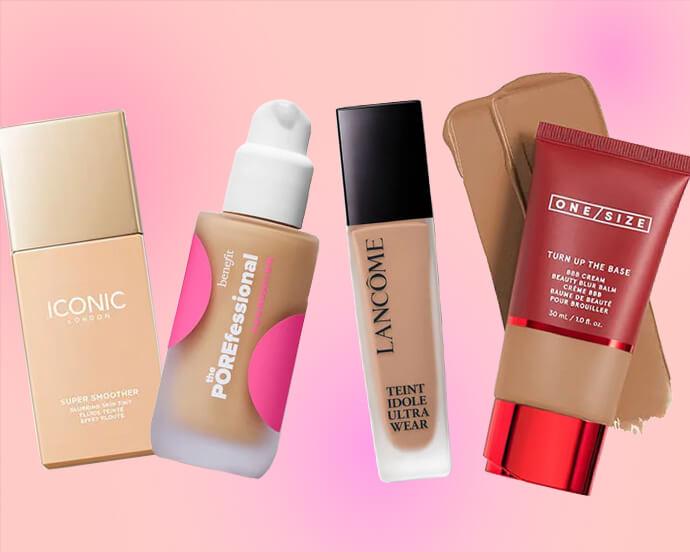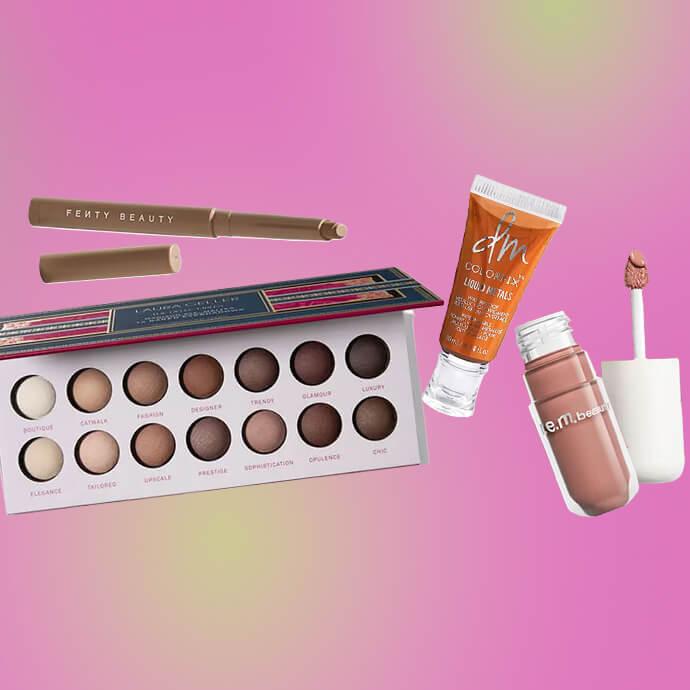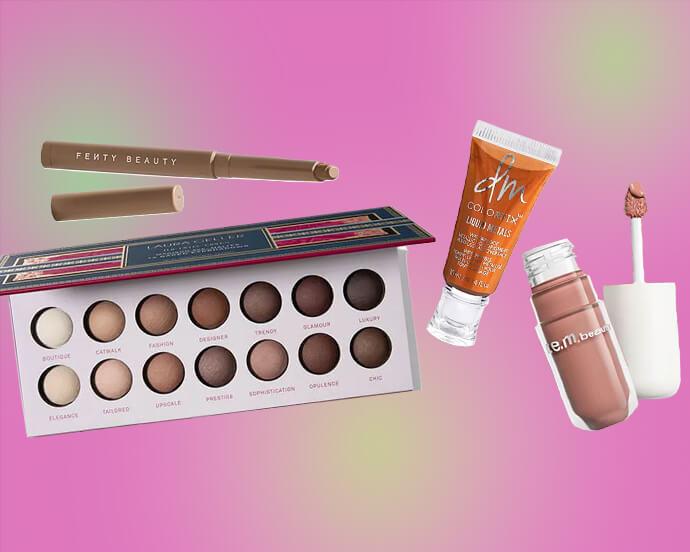Here’s Exactly How to Clean Your Makeup Brushes to Keep Them Like New



Pia Bhattacharya


We shampoo our hair, cleanse our faces, and wash our clothes diligently (*side-eyeing that growing laundry*), but how often do we actually clean our makeup brushes? You know, the brushes and sponges we’re dabbing, blending, and swiping our faces with daily to perfect our makeup look? If you can’t remember the last time you gave yours a good scrubbing, it’s probably (scratch that— it’s definitely) time for a makeup brush bath.
Your makeup brushes hold onto product really well, but they also cling to dirt, oils, product buildup, and bacteria that, if not properly cleaned away, can get transferred back onto your skin. This can cause all kinds of not-so-fun problems like breakouts, clogged pores, and skin irritation—and not to mention, dirty makeup brushes just don’t do their job very well for a flawless application.
No idea how to clean makeup brushes? We don’t judge. The good news is, it’s actually really easy to DIY (and super satisfying, TBH). Think of it as another measure to take to aid in your skincare journey. To help you out, we’ve created a simple guide to cleaning brushes with the help of makeup artists Brenna D, Berenz Castro, and Alex Levy. Trust us, your skin and your makeup will thank you.


It's about glam time you treated yourself.
MEET THE EXPERT
Brenna D is a makeup artist, hair stylist, and groomer based in New York City.
Berenz Castro is a Los Angeles-based hair and makeup artist who has expertly styled talent in the entertainment, commercial, and fashion industries for the past decade.
Alex Levy is a New York–based makeup artist and beauty marketing consultant.
Ready to Start Cleaning Your Brushes? Here’s What You’ll Need:
Your brushes, of course
A bowl of lukewarm water
A gentle soap, gentle shampoo, or makeup brush cleanser. “Good ole Dawn or any dish soap is hard to beat, and is definitely cheaper than most brush-specific shampoos. They cut down on grease and oil-based makeup, as well as powder products,” says Alex Levy.
A clean, dry towel or paper towels
How to Clean Your Makeup Brushes Like a Pro
Brenna D breaks down her best brush cleaning method step-by-step below. But before you get started, it’s important to know what your brushes are made of. She says: “Natural hair brushes are best used with powder products, whereas synthetic brushes are best used with liquids and creams. Synthetic brushes can handle a wider range of cleaning agents where natural bristles, and those comparable, can become dry and rough quicker.” Brush material checked? Now let’s get scrubbing.
“First, separate your brushes by how they need to be cleaned and set up your station with soap, access to warm water, a clean towel, and a clean space to lay your brushes to dry.”
“Then, take your brush and wet the bristles with warm water. Avoid wetting the ferrule, as it can loosen the glue holding the bristles in place.”
“Get soap or makeup brush cleaner on the bristles and swirl the brush in a circular motion on your palm or a brush glove, adding water as needed. Use your fingers to get in between the brush hairs, as dirt and oil can hide in the center.”
“Rinse all of the soap from the bristles. You may need to repeat, but try using less soap the second or third time.”
“Squeeze the excess water from the brush with your hand or towel and be mindful not to pull on the bristles while doing so.”
“Finally, shape any brushes that may have lost their shape while washing and lay them flat to air dry in a clean, warm place. For extra sanitization, wipe down the ferrule and handle with 70% alcohol.” Another pro tip from Brenna D: “I lay my brushes on a sanitized baking cooling rack for a faster dry time. I learned this tip from celebrity makeup artist Wendi Miyake.”
More Ways to Clean Your Brushes
When it comes to well, anything, we love to have options. Lucky for you, you can clean your makeup brushes in many ways. When you don’t have time for a hands-on brush washing sesh, here are three foolproof methods to get them squeaky clean.
1. Use a brush cleaning solution: Brenna D says, “Opt for a quick ‘no water’ solution. I've been using the CINEMA SECRETS quick-dry brush cleaner solution for the past 12 years—it’s my favorite. It can dry out natural hair brushes if used too frequently, but it’s great for synthetic brushes, in-between cleanings, and quick sanitization if you don’t have time or access to water.” Castro adds, “Using a soap with moisturizing benefits will hydrate your bristles and give them a longer life span overall.” We love a hydrating solid soap like JAPONESQUE Coconut Solid Brush Cleaner.


2. Use a specialized brush cleaning tool: A deep-cleaning mitt like SIGMA BEAUTY 2X Sigma Spa® Brush Cleaning Glove has two specially textured sides, one for face-makeup brushes and the other for eye-makeup brushes, to thoroughly remove all traces of residue and buildup. There are also tons of silicone brush cleaning mats on Amazon.


3. Try a DIY cleanser: A popular homemade brush cleanser is a mixture of dish soap and olive oil at a one-to-one ratio. The dish soap kills germs, while the oil helps break down built-up product. When you’re in a bind, Brenna D says, “Cleaning your brushes with a non-drying shampoo, baby shampoo, face wash, or mild dish soap once a week is better than not cleaning them at all.”
How Often to Clean Your Makeup Brushes?
Brenna D says, “There are a few things to consider, but the basic rule of thumb is once a week. If you have sensitive skin, are prone to breakouts, or use creamy, heavier products, consider cleaning them more often.” Castro adds that if you’re applying makeup on others, they should be washed thoroughly before and after. "As a professional, I work on different faces, so I clean my brushes every time I have a new client," Castro says. "I have about three to four sets of my favorite brushes with me, always."
Worried about time? “Deep cleaning is best with soap and water, but brushes can be spot cleaned for on-the-go with brush cleansers that dry quickly, so you don’t have to wait to use them after washing, says Alex. Cleaning your brushes doesn’t always have to be a complicated chore.
Makeup sponges require a bit more upkeep than brushes. "A BEAUTYBLENDER should be cleaned after every use," says Castro. "The wetness is the perfect breeding ground for bacteria that will cause breakouts. Try to wash it as soon as you finish using it, and let it dry for its next use.” Tip: Check out this tutorial on how to clean a makeup sponge.
When Is It Time to Say Goodbye to a Brush?
We know it’s hard, but sometimes breaking up with your brushes is the way to go. High-quality natural brushes should last for years with regular upkeep, while synthetic bristles can typically handle more wear and tear. Either way, Brenna D says, “When a brush gets coarse, it's definitely time to replace it. If a brush has lost its shape or is fraying, replacing it is also a good idea.”
And cleaning makeup sponges? They’re typically meant to last about three months, as sponges can be a magnet for bacteria and gunk. A good way to remind yourself to restock is to swap your sponge for a new one every time the season changes.
How to Extend the Life of Your Makeup Brushes
According to Brenna D, there are a few things you can do to help your brushes and makeup sponges last longer.
Separate your lights and darks: “I recommend designating brushes for light products and dark products for easier cleaning and maintenance. Also, if you have certain brushes that you are using and cleaning more frequently than others, purchase a few of them. Keeping them in rotation can elongate their lifespan.”
Avoid heat and humidity: “Avoid keeping your brushes in a damp place (like next to the shower) or in direct sunlight.”
Minimize dust: “I like makeup brush slotted organizers, mugs, or vases, but if the area tends to get dusty, consider something with a lid.”
Keep them separated: “If you have a lot of brushes, spread them out so there’s less chance of cross-contamination.”
Want more makeup tools and tips for how to use them? Take our Beauty Quiz now to get started. Already an Ipster? Refer your friends to earn points, which you can use toward products. Either way, don’t forget to check us out on Instagram and Twitter @IPSY.
Like this article? Share it with your friends by clicking the icons below!
Liked this post? Share!
Related Stories


Makeup
Want an IRL Filter? These Are the Best Blurring Foundations
Published on Dec 12, 2025 • 5 min read


Makeup
How to Expertly Apply Eyeshadow on Mature Skin
Published on Dec 10, 2025 • 6 min read


Makeup
How to Use Bronzer and Contour to Sculpt Your Face Like a Pro
Published on Dec 5, 2025 • 9 min read


Makeup
Makeup for Older Women That Works With Your Skin, Not Against It
Published on Dec 1, 2025 • 12 min read


Makeup
2026’s Biggest Makeup Trends Are a Maximalist Dream
Published on Dec 1, 2025 • 8 min read


Makeup
2025’s Biggest Makeup Trends: Go Big or Go Home
Published on Dec 13, 2024 • 7 min read


Makeup
16 New Year’s Eve Makeup Ideas to Fashionably Ring in 2026
Published on Nov 25, 2025 • 10 min read


Makeup
Your 2026 Beauty Horoscope Is Here—and the Stars Are Serving Looks
Published on Nov 25, 2025 • 9 min read


Beauty Picked Just for You
Get 5 products worth up to $70
Plus exclusive access to epic deals up to 80% off
Starting at just $14/month. Cancel anytime.